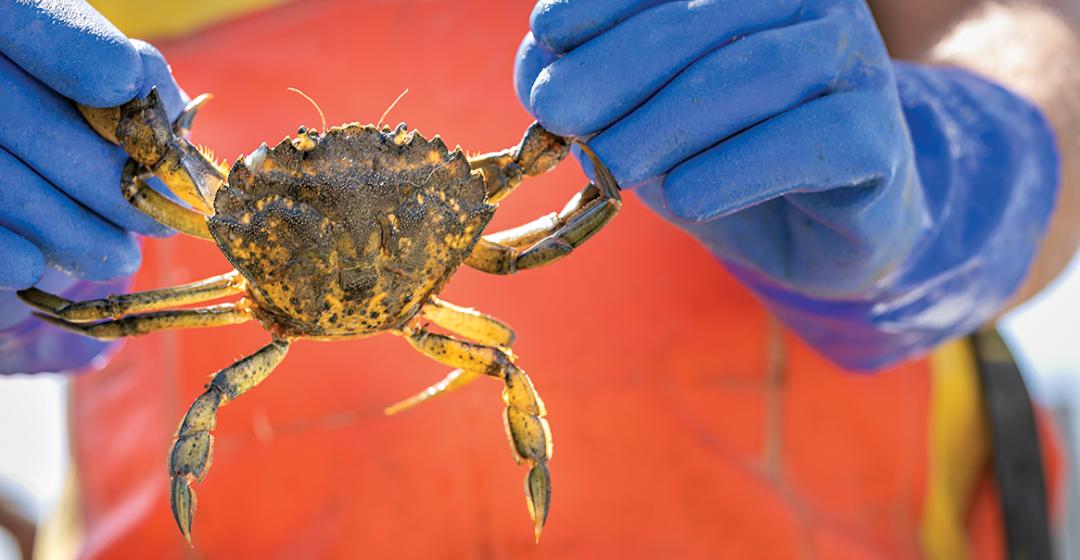By the end of September, members of the Tisbury Shellfish Department will have begun emptying wood rafts used to grow quahaugs. Months ago, the animals were placed in the partially submerged sand-filled trays the sizeof a sheet of plywood when they were about the size of a speck of sand. Sifted out they are now as big as an M&M candy.
In the weeks that follow, thousands of these juvenile quahaugs will be spread by hand in the waters of the Lagoon and Tashmoo Pond. A small percentage will grow to a legally harvestable size in approximately three years and be ready to
be raked up by recreational and commercial shellfishermen. But not if the green crabs get them first.
The Latin name for the green crab, Carcinus maenas, translates as “raving mad crab,” which gives some insight into the personality of this dark green, mottled crustacean with a voracious and wide-ranging appetite that is undermining the Island’s valuable commercial and recreational shellfish resources. C. maenas aggressively prey on juvenile shellfish and fish, including hard- and soft-shell clams, oysters, mussels, bay scallops, snails, worms, and winter flounder – practically anything it can get claws on. In searching for food, it clips and uproots eelgrass, destroying vital nursery habitat for a variety of marine species, and destabilizes salt marsh banks with its burrows.
Native to Europe and ranked by scientists as among the most invasive species in the marine environment, the green crab arrived on the East Coast of North America in the 1800s, likely in the ballast and bilge water of merchant ships from Europe. It has since spread as far north as Nova Scotia.
More recently, it has been seen on the West Coast, and its northward migration associated with climate change has set off alarm bells. Having seen the softshell clam industry collapse in New England, Washington State and Alaska fisheries officials consider the green crab a serious threat to the Dungeness crab, oyster, and clam fisheries, and aquaculture operations in the Pacific Northwest and British Columbia.
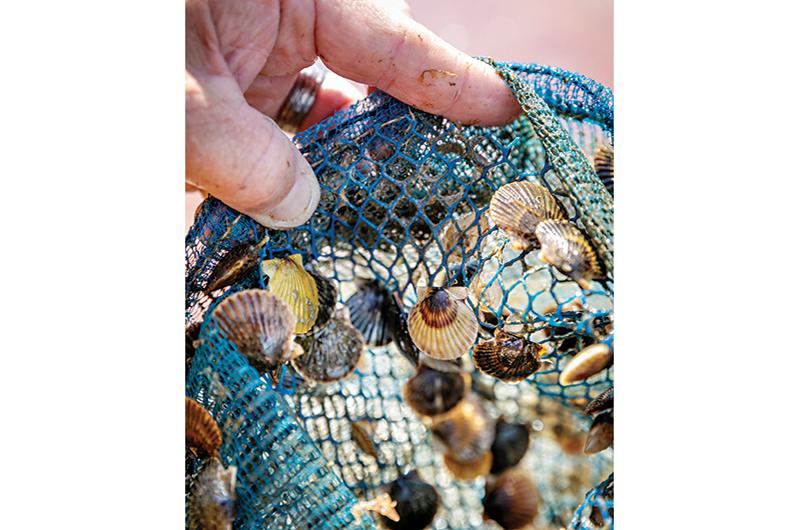
“They’re huge, huge predators of shellfish,” said Emma Green-Beach, executive director of the Martha’s Vineyard Shellfish Group (MVSG), a nonprofit supported by the six Island towns that operates a shellfish hatchery and conducts related research. “They’re adaptable, smart, and they have these mechanisms that allow them to really take hold in the ecosystem, as they have done, and out-compete other native predators.”
Culturally, economically, and environmentally, oysters, bay scallops, and quahaugs are important to Islanders. To combat degraded water quality, which is linked to development, and a host of predators, Island towns spend heavily on municipal shellfish propagation to underpin Mother Nature. In 2021, the six towns each contributed $38,000 to the MVSG. In return, according to the MVSG annual report, their shellfish departments received a share of the shellfish hatchery’s seed output of 11.3 million quahaugs, 21.1 million scallops, and 7 million oysters, each about the size of a pencil point. The Wampanoag Tribe of Gay Head (Aquinnah) received scallop seed under a separate contract.
Once received, town shellfish managers employ various methods to protect and grow hatchery seed over the summer growing season. The juvenile seed is generally released in the fall. Survival to adulthood is contingent on many factors, including the size of the shellfish when it is released, weather, habitat, and predation. But Chilmark shellfish constable Isaiah Scheffer is clear-eyed in describing how the green crab affects his efforts. “I have no doubt in my mind that they’re the number-one killer of the seed that we put out,” he said.
To illustrate what he is up against, Scheffer described what happened when a mesh bag containing hundreds of tiny scallops dropped off a hook on the side of his workboat while he was gone for a few hours. “There were seven or eight green crabs around it, and they had chewed through the bag, and most of the scallops had already been crushed up – they were even crushing them up from outside the bag, and there had to have been three or four hundred scallop seed just demolished in a period of a couple of hours, so that ought to tell you something.”
Shellfishermen in Maine know all they care to know about the green crab, which is responsible for devastating the state’s soft-shell clam industry. Between 1950 and 1954, a warming trend in the Gulf of Maine led to an invasion of green crabs, the marine equivalent of a biblical swarm of locusts.
Brian F. Beal, professor of marine ecology and director of the Marine Science Field Station at the University of Maine at Machias, said the effect was economically devastating. “When those green crabs exploded, people lost their jobs,” he said. “They just couldn’t make any money digging clams.”
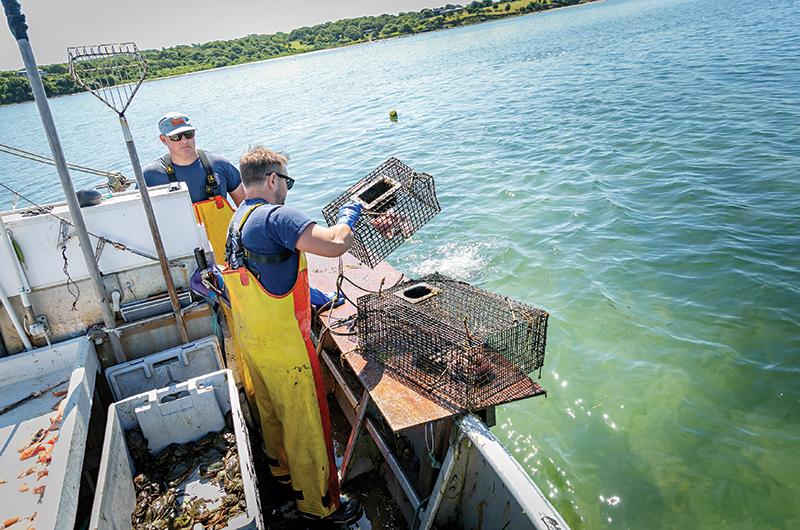
Water temperatures in the Gulf of Maine are as warm now as they were in the ’50s, said Beal. “And we’re seeing an absolute repeat of the past where nothing is able to keep these green crab populations in check.
“I call them the consummate invader because they can live in just about any habitat – inter-tidal, sub-tidal – they can live under rocks, or under algae, they have a tremendous physiological tolerance for warm temperatures, so that’s why, at least on the coast of Maine, when we have mild winters we see more green crabs and zero year-class clams or recruits,” he added.
To put it more bluntly, Beal said only one thing keeps green crabs in check: “Cold, cold, cold…We need lots of ice to be forming on these mudflats and lasting four to six weeks – water temps down to 31, 32, 29 Fahrenheit.” But a rise in ocean temperatures associated with climate change does not bode well for the future. He paints a grim picture of the continuing destructive influence of the green crab on shellfish ecosystems and the daunting challenge of controlling a species designed to survive a wide range of conditions.
Green crabs are highly fecund – a two-inch animal can produce about 165,000 eggs. And a single adult green crab can eat up to forty juvenile softshell clams in a single day, meaning most clams don’t even have the chance to reach adulthood, by which time they can hide deeper in the substrate.
“It gets to [be] a race between crab growth and clam growth, and if you can give the clams an advantage by planting them early, and/or planting them large, that’s part of the key to success,” he said.
It’s a race with which Bill Walton, Acuff professor of marine science and the shellfish aquaculture program coordinator at the Virginia Institute of Marine Science, is familiar.
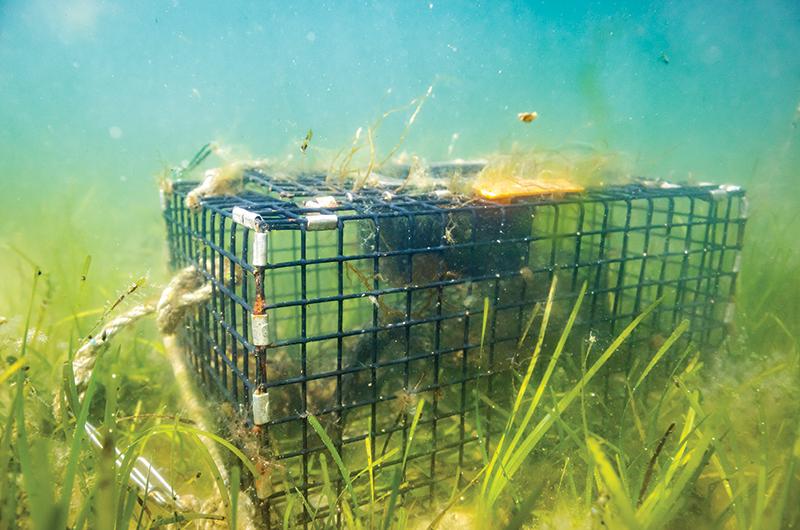
In 1996, Walton was a young doctoral student at the University of Maryland when he began a three-year study on the effects of green crabs on hard-shell clams on Martha’s Vineyard. Walton worked closely with Island shellfish constables and Rick Karney, retired MVSG director emeritus. His dissertation, “Mitigation of Predation by the European Green Crab Carcinus Maenas on Publicly Cultured Hard Shell Clams Mercenaria Mercenaria,” was published in 2003.
Among his conclusions, Walton wrote, “Larger green crabs are the major predators of hard-shell clam seed” and that seed under eleven millimeters (.43 inch) “are especially vulnerable to predation.”
His recommendations included releasing larger seed – greater in size than nineteen millimeters, or at least above eleven millimeters “if the former is not practical” – and conducting “intensive trapping only during the first two weeks after seed release (rather than all season) for the most cost-effective method of increasing restoration success.”
Walton has a great love for shellfish. He began his career as a Wellfleet constable and recalling that experience he echoes sentiments that are familiar to many Islanders who have held a shellfish rake. “I fell in love with the idea of being able to grow shellfish. It’s so satisfying to see these animals grow,” he said. “You’re not feeding them. You’re not medicating them. And they’re growing, and the environment that they’re in is reflected in their shells; it’s just amazing, isn’t it?”
He also has shellfish to thank for his family. “When I started my dissertation Rick Karney was kind enough to take me under his wing, and Beth [now Walton’s wife] was working at the hatchery, and the rest is history. We met there, and we returned to the Vineyard to have our wedding there.”
But he knows the shellfish are in trouble. Asked what could be done to reverse the notable decline of bay scallops in Island waters, Walton said because scallops are so short-lived and spawn after only one year of growth, one approach may be to create dense aggregations of animals in corners of the water bodies where they are less susceptible to predation “so that when they spawn it increases the chance of really successful fertilization and a ton of larvae in the water.”
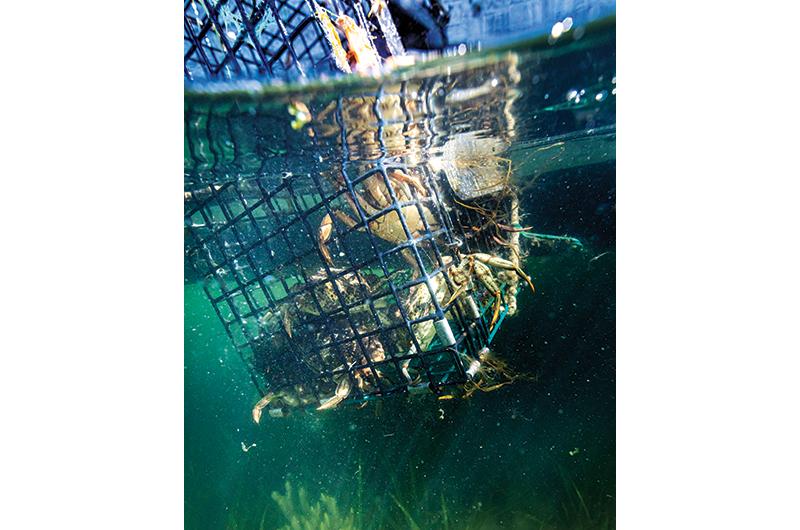
It’s possible “that already happens every year and that all those baby scallops, maybe there are gazillions of them, and that they’re all decimated by predation because the eelgrass is not there,” he said. “That’s also a possibility. Which brings us back to the green crabs.”
Trapping could at some level reduce predation enough to make it worthwhile, he said, “not in terms of getting rid of green crabs, but in terms of managing their predation.”
It’s a potential tool, in other words. “What is not clear,” he said, “is whether the benefits outweigh the costs involved.”
Island shellfish constables are a dedicated lot who spend considerable time raising shellfish. Some trap crabs, some do not.
On the Chilmark side of Menemsha Pond, Scheffer regularly deploys 100 traps. He estimates he removes three full totes of crabs – 400 to 500 crabs per tote – weekly. The crabs are given to conch fishermen to use for bait.
“I think I’ve actually put a little dent in the numbers [of green crabs], but it’s inexhaustible in our pond; they just keep coming in,” he said. Scheffer focuses trapping on areas where he releases quahaug and scallop seed. The only way to mitigate the predation, he said, is to grow the scallop seed to a larger size, “over thirty-five millimeters, to have a chance to survive.”
The Wampanoag Tribe’s natural resources department, working with the town of Aquinnah, follows a similar targeted strategy to raise scallops on the west side of the pond. Andrew Jacobs, tribal laboratory manager/environmental technician, said the Tribe had been involved in predator control efforts since 2005 when a federal grant was used to fund a three-year trapping study. The Tribe fished fifty traps and removed a total of 52,000 crabs, he said.
“This vast removal of scallop predators, in conjunction with other shellfish propagation methods, gave rise to a population boom for the diminishing bay scallop from 400 bushels in 2005 to 4,000 bushels in 2008,” Jacobs said.

The Tribe has since scaled back the labor-intensive, wide-ranging trapping effort to about thirty traps. It now focuses on protecting an annually rotating section of eelgrass it sets aside as a scallop seed sanctuary. He said the predator control program averages around 7,000 crabs removed each year, with spider crabs, rock crabs, and the green crab being the predominant species removed.
Likewise, in the past Edgartown offered a per pound bounty for green crabs. Today, Edgartown shellfish constable Robert Morrison prefers to direct his efforts to grow shellfish. He relies on the natural environment and a focus on propagation to counter juvenile shellfish predation: he plants seed quahaugs in pea stone gravel beds in Katama Bay. The gravelly bottom deters lady and green crabs because they don’t like to forage through it.
Edgartown is fortunate that Cape Pogue Bay remains virtually free of development and maintains lush eelgrass beds. “Without that eelgrass habitat, we wouldn’t have a vibrant scallop fishery,” Morrison said. “It gives the juvenile scallops a place to hide.”
Another bright spot is an abundance of soft-shell clams in Edgartown Great Pond. Morrison said he’s only recently started to see evidence of green crabs in the pond. A feisty and aggressive species native to the Island and one of the primary predators of shellfish, he said, is the blue claw crab, which may help keep green crabs in check. Morrison attributes the health of the pond and the abundance of shellfish to having plenty of food, good habitat, and successful pond openings to the sea, which cause the salinity of the pond to fluctuate.
“I also think it’s like any kind of shellfish, when all the stars align and there’s a good set of steamers and the conditions are right we’ll get a good crop – some years go by when that doesn’t happen,” he said.
Biologists generally agree that there is no practical, cost-effective method to remove green crabs from an ecosystem once they gain a foothold. In some cases, trapping may have the opposite effect. Beal points to a study by a team from the University of California, Davis. Following a five-year effort to eradicate the green crab in Seadrift Lagoon, a small estuary in central California, the green crab population jumped from approximately 10,000 to 300,000 crabs.
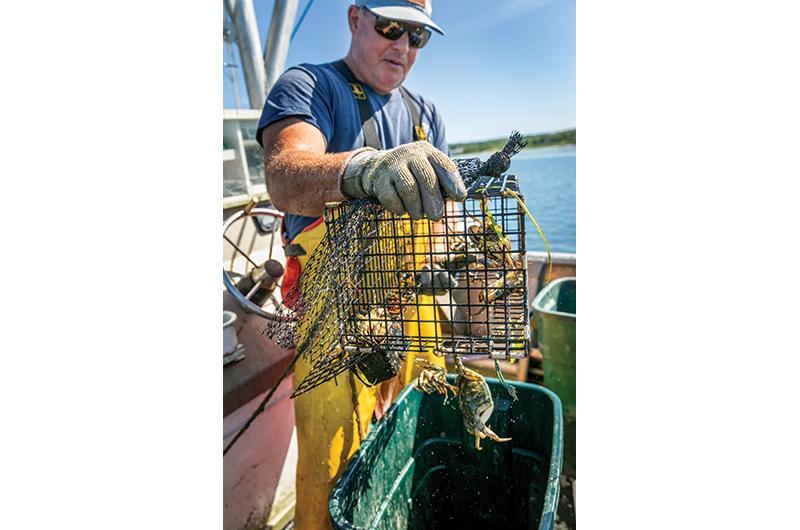
What the study documented and termed “the hydra effect” found that adult green crabs are cannibalistic and keep juvenile crabs in check. By removing adults, the overall population actually flourished.
Said Beal: “You might just as well do nothing as trap green crabs in an open system.”
However, there is some evidence that trapping in naturally enclosed bays and estuaries may help mitigate crab predation.
After identifying green crabs as the cause of the disappearance of eelgrass and soft-shell crabs from an estuary in Nova Scotia’s Kejimkujik National Park, Parks Canada mounted an intensive trapping effort. From 2010 to 2017, a team of biologists, fishermen, students, and volunteers fished fifty to 140 traps in the 269-acre estuary about the size of Lake Tashmoo. They emptied traps and counted crabs every day.
Parks Canada marine conservation senior advisor Gabrielle Beaulieu said the program, which she described as “quite an undertaking,” removed two million crabs. She said there was an increase from 2 percent eelgrass cover in the estuary to 34 percent, about a third of the historical cover, and small juvenile clams, the preferred prey of green crabs, were turning up in larger numbers.
Closer to home, the North Shore towns of Ipswich, Rowley, Essex, Newbury, and Gloucester share marsh and wetland habitats that are home to the richest soft-shell clam beds in Massachusetts. The towns run a trapping program subsidized by a $10,000 earmark in the state budget and overseen by the Division of Marine Fisheries.
Gloucester shellfish constable Peter Seminara said the two participating commercial fishermen set up to sixty traps each in the fall. They receive forty cents per pound until the subsidy is exhausted, plus whatever they can make selling their catch.
Seminara said the trapping makes a difference. “We’ve experienced extensive natural recruitment in areas that were heavily targeted by the green crab fishermen.” The fishermen harvest one thousand pounds a day and go out every single day. They sell the crabs to bait dealers, compost companies, feed companies, “anyone that will take them, really; they have to find their own market.”

On Nantucket, the approach has been to enlist the public in finding ways to use green crabs, on the menu and in the garden. Green crabs are considered a serious threat to that island’s healthy eelgrass beds and bay scallop fishery.
In 2020, two prominent Nantucket conservation organizations, the Maria Mitchell Association (MMA) and The Nantucket Land Council (NLC), created “Nantucket Green Crab Week.”
Jack Dubinsky, MMA aquarium director and research center coordinator, said they “began green crab week to raise awareness of what is a huge issue on Nantucket.” Activities include cooking demonstrations, turning green crabs into nitrogen-rich fertilizer by chipping them up, and even hosting a “green crab derby” for kids. “We’re trying to show people how they can use green crabs, so they’re incentivized to collect them on their own,” he said.
People who use green crabs for fertilizer are encouraged to send in photos of their gardens, said R.J. Turcotte, NLC resource ecologist. “We’re trying to show people what they can do with them.” That includes eating them.
Due to their small size, green crabs are not a popular culinary choice – it’s difficult to pick the meat off them to use in crab cakes or crab boils. But they can be eaten whole when they shed their shell during their molting stage. In the Venice region of Italy, “Moleche,” – or deep-fried soft-shelled green crab, is considered a delicacy.
Whether or not New Englanders will make the leap remains a question. For would-be suppliers, the trick is recognizing just before a green crab is about to molt – shed its hard shell and begin to grow a new one – at which point it can be eaten before its new shell hardens.
“We’re hoping to get to a point where we can teach those fishermen who are interested how to do it,” Turcotte said.
Professor Beal is skeptical. “On face value, it’s fine,” he said, “but if you think you’re going to mitigate the effect of green crabs on shellfish by eating them, then think again.”
Beal admits he paints a bleak picture of the effectiveness
of trapping and promoting the green crab’s culinary attributes. “I don’t do it because I’m an idiot,” he said. “I do it because I want to be truthful, and I want to tell people what the research shows."

